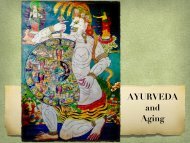How Thoreau's Walden Pond Mixed with the Ganges and Yoga Came to America with Swami Vivekananda
One early morning in 1846, during the coldest days of a New England winter, Henry David Thoreau looked out the window of his small cabin on Walden Pond and saw men cutting its ice into blocks. That ice was hauled by horse to a railroad that ran across the western edge of Walden Pond, packed into a boxcar, taken to Boston and loaded onto a clipper ship that sailed to Calcutta, India, arriving about four months later. Once there, that ice was purchased by grateful members of the East India Company. Thoreau had witnessed a small part of the global ice trade between New England and India that took place during the latter part of the nineteenth century. When Thoreau considered the ice trade, his vision sailed on metaphors far beyond the scope of business. The waters he imagined flowed both east and west and carried not just natural elements, but culture, religion and philosophy as well. He envisioned that after arriving in Calcutta, the New England ice of Walden Pond would eventually melt and run downhill where it would join with the sacred water of the Ganges. He wrote in Walden: "It appears that the sweltering inhabitants of Charleston and New Orleans, of Madras and Bombay and , drink at my well. In the morning I bathe my intellect in the stupendous and cosmogonal philosophy of the , since whose composition years of the gods have elapsed, and in comparison with which our modern world and its literature seem puny and trivial; and I doubt if that philosophy is not to be referred to a previous state of existence, so remote is its sublimity from our conceptions. I lay down the book [Bhagavad-Gita] and go to my well for water, and lo! there I meet the servant of the Bramin, priest of and and who still sits in his temple on the Ganges reading the , or dwells at the root of a tree with his crust and water jug. I meet his servant come to draw water for his master, and our buckets as it were grate together in the same well. The pure Walden water is mingled with the sacred water of the Ganges." This book tells the story of these waters . . .
One early morning in 1846, during the coldest days of a New England winter, Henry David Thoreau looked out the window of his small cabin on Walden Pond and saw men cutting its ice into blocks. That ice was hauled by horse to a railroad that ran across the western edge of Walden Pond, packed into a boxcar, taken to Boston and loaded onto a clipper ship that sailed to Calcutta, India, arriving about four months later. Once there, that ice was purchased by grateful members of the East India Company. Thoreau had witnessed a small part of the global ice trade between New England and India that took place during the latter part of the nineteenth century.
When Thoreau considered the ice trade, his vision sailed on metaphors far beyond the scope of business. The waters he imagined flowed both east and west and carried not just natural elements, but culture, religion and philosophy as well. He envisioned that after arriving in Calcutta, the New England ice of Walden Pond would eventually melt and run downhill where it would join with the sacred water of the Ganges. He wrote in Walden: "It appears that the sweltering inhabitants of Charleston and New Orleans, of Madras and Bombay and , drink at my well. In the morning I bathe my intellect in the stupendous and cosmogonal philosophy of the , since whose composition years of the gods have elapsed, and in comparison with which our modern world and its literature seem puny and trivial; and I doubt if that philosophy is not to be referred to a previous state of existence, so remote is its sublimity from our conceptions.
I lay down the book [Bhagavad-Gita] and go to my well for water, and lo! there I meet the servant of the Bramin, priest of and and who still sits in his temple on the Ganges reading the , or dwells at the root of a tree with his crust and water jug. I meet his servant come to draw water for his master, and our buckets as it were grate together in the same well. The pure Walden water is mingled with the sacred water of the Ganges."
This book tells the story of these waters . . .
You also want an ePaper? Increase the reach of your titles
YUMPU automatically turns print PDFs into web optimized ePapers that Google loves.
Kundalini Shakti<br />
“One energy <strong>with</strong> many names <strong>and</strong><br />
forms: There is one energy that<br />
keeps taking on new shapes <strong>and</strong><br />
forms. In Tantra <strong>the</strong> name of that<br />
energy is Shakti, which is <strong>the</strong> manifesting,<br />
or feminine force that is actually<br />
one <strong>and</strong> <strong>the</strong> same <strong>with</strong> its only<br />
apparent companion Shiva, <strong>the</strong> latent,<br />
or masculine. Each time <strong>the</strong> energy<br />
takes on a new form, we give it<br />
a new name. Shakti becomes Kundalini Shakti, or simply Kundalini. Kundalini<br />
becomes <strong>the</strong> energy of Prana, which flows in patterns or channels called Nadis,<br />
<strong>and</strong> concentrates itself by forming intersections known as Chakras. The subtle<br />
energies condense <strong>and</strong> become known as earth, water, fire, air, <strong>and</strong> space, forming<br />
our experience of <strong>the</strong> gross world. With Kundalini awakening, <strong>the</strong> primal energy<br />
of Shakti awakens in its true form.<br />
Seek <strong>to</strong> experience that one energy: To know, in direct experience, that unchanging<br />
truth, <strong>the</strong> one energy that is <strong>the</strong> substratum of all of <strong>the</strong> names <strong>and</strong><br />
forms, is one of <strong>the</strong> ways of describing <strong>the</strong> universal goal of spiritual life. It is <strong>the</strong><br />
experience of <strong>the</strong> union of Shakti <strong>and</strong> Shiva, creation <strong>and</strong> its ground, feminine<br />
<strong>and</strong> masculine, even though <strong>the</strong>y were never actually divided in <strong>the</strong> first place. It<br />
is like wetness that is never separate from water, sweetness that is never separate<br />
from sugar, <strong>and</strong> warmth that is never separate from sunlight.”<br />
— Hindupedia<br />
Related Glossary Terms<br />
Drag related terms here<br />
Index<br />
Find Term<br />
Chapter 1 - <strong>How</strong> <strong>Thoreau's</strong> <strong>Walden</strong> <strong>Pond</strong> <strong>Mixed</strong> <strong>with</strong> <strong>the</strong> <strong>Ganges</strong> <strong>and</strong> <strong>Yoga</strong> <strong>Came</strong> <strong>to</strong> <strong>America</strong> <strong>with</strong> <strong>Swami</strong> Vive


















